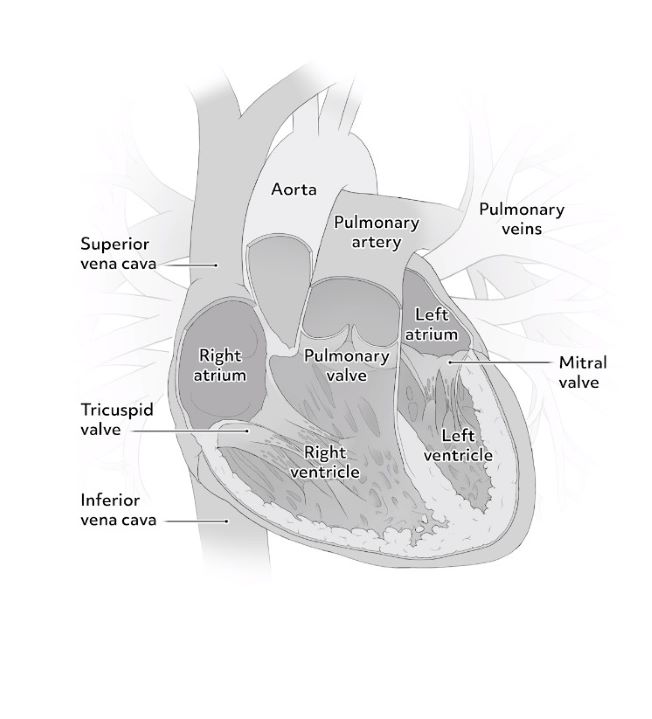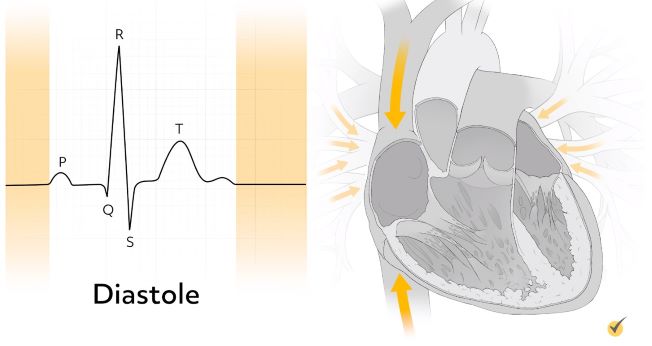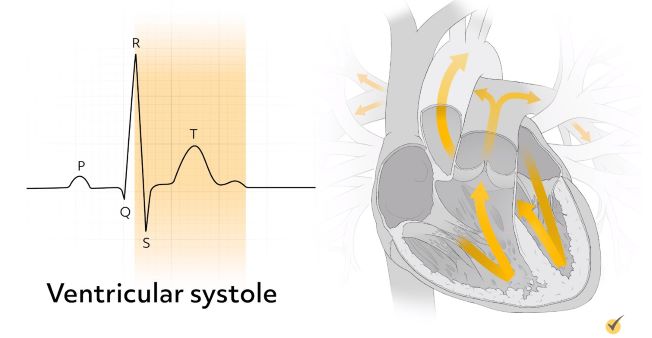
Welcome to this video about the cardiovascular system and the difference between systolic and diastolic blood pressure.
Anatomy of the Heart
The adult heart is about 14 by 9 centimeters in size and lies in the mid chest, with about one third on the right side, and two-thirds on the left side between the second rib and fifth intercostal space.

The heart has four hollow chambers: the right atrium, left atrium, right ventricle, and left ventricle.
The heart is an extremely efficient pump, capable of pumping 7,000 liters of blood throughout the body every day.
Blood Flow Through the Heart
The superior vena cava and inferior vena cava bring venous blood, which is low in oxygen and high in carbon dioxide, to the right atrium of the heart.
As the pressure increases in the right atrium, the atrium contracts and the tricuspid valve opens and blood fills the right ventricle. When the pressure builds up in the right ventricle, the tricuspid valve closes and the pulmonic valve opens. The ventricles contract and blood from the right ventricle enters the pulmonary artery and flows to the lungs where it is oxygenated.
Then, the blood, now high in oxygen and low in carbon dioxide, returns to the left atrium of the heart through the pulmonary vein. As the pressure builds in the left atrium, it contracts and this opens the mitral valve and blood flows into the left ventricle, causing the pressure to fall in the left atrium and rise in the left ventricle, forcing the mitral valve closed again and opening the aortic valve. With the next ventricular contraction, blood flows from the left ventricle into the aorta and out into general circulation.
Systolic and Diastolic Phases
In a normally functioning heart, the atria both contract simultaneously, and the ventricles also contract simultaneously. Thus, blood is constantly flowing in and out of the heart.
The “lub-dub” sound that is often used to describe the heart beat results from the valves closing. The first part, “lub,” indicates that the atria are contracting, and the second part, “dub,” indicates the ventricles are contracting.

Systole is the state when the atria or ventricles are contracting and diastole is the state when the atria or ventricles are at rest. When we speak of systole and diastole, we most often refer to ventricular systole and diastole, although the atria go through the same cycles. Systole is one-third and diastole two-thirds of the normal cardiac cycle.
Systolic and Diastolic Readings
So, how does this relate to blood pressure readings?
Blood pressure is the pressure of the blood against the walls of the vessels when the ventricles are contracting and when they are at rest.
When the left ventricle contracts during ventricular systole, the blood is forced under high pressure into the aorta and branching arteries, increasing the pressure in the arteries and dilating the vessel walls, creating the pulse that we can feel or hear with a stethoscope.
The pressure in the arteries is greatest during ventricular contraction, and this is the systolic blood pressure reading. Between pulses when the ventricles and arteries are at their most relaxed state, this is the diastolic blood pressure reading.

The difference between the systolic and diastolic pressures creates the force that moves the blood from the large arteries to the arterioles and to the arterial capillaries where it then joins the venous capillaries and begins to circulate back to the heart. The usual difference is about 40 millimeters of mercury (mmHg).
Factors Affecting Systolic Blood Pressure
Anything that alters the diameter of the arteries can affect the systolic blood pressure. This can include changes in cardiac output or stroke volume, exercise, nutritional differences, disease, and drugs.
Stress, for example, can bring about vasoconstriction, so that when the ventricles contract, the diameter of the arteries is smaller, and the pressure of the blood against the vessel walls is greater, increasing the systolic blood pressure.
Atherosclerosis (or, the buildup of fatty plaque along the walls of the arteries) can result in stiff arteries with a narrow lumen, markedly increasing the systolic pressure. In order to compensate for this increase, the diastolic pressure also usually increases so the resting state remains increasingly tense. As the blood pressure increases, the risk of heart attack or stroke also increases.
In some cases, only the systolic blood pressure increases while the diastolic blood pressure remains low, but this also increases risk of heart attack or stroke. Most often, this type of blood pressure is found with another disorder, such as diabetes mellitus, hyperthyroidism, obstructive sleep apnea, and anemia.
The Importance of Diastolic Blood Pressure
People are often most concerned about increases in systolic blood pressure, but increases in diastolic blood pressure are equally concerning as each increase of 10 millimeters of mercury in those age 40 and older doubles their risk of having a heart attack or stroke.
Factors that can increase diastolic blood pressure include:
- A diet high in sodium
- Obesity
- Excessive alcohol consumption
- Lack of exercise
- Medications and drugs (e.g., oral contraceptives, corticosteroids, antidepressants, caffeine, and amphetamines)
Blood Pressure Categories and Age Considerations
According to the American College of Cardiology 2017 guidelines, blood pressure categories include:
- Normal blood pressure: Which is less than 120/80 mmHg
- Elevated blood pressure: Which is a systolic pressure of between 120 and 129 mmHg and diastolic pressure of less than 80 mmHg
- Stage 1 hypertension: Which is a systolic pressure between 130 and 139 mmHg or a diastolic pressure between 80 and 89 mmHg
- Stage 2 hypertension: Which is a systolic pressure of at least 140 mmHg or diastolic pressure of at least 90 mmHg
Blood pressure, of course, varies with age and should always be monitored along with the heart rate and respirations, as changes in one of these factors will affect the others. Usually only the systolic blood pressure is monitored in neonates, toddlers, and preschoolers.
In neonates, the systolic blood pressure ranges from 70 to 90 mmHg, but by school age (between and 12), the blood pressure is near that of adults, ranging from 80 to 120 systolic and 60 to 80 diastolic, depending on age and size.
That’s all for now—thanks for watching and happy studying!

